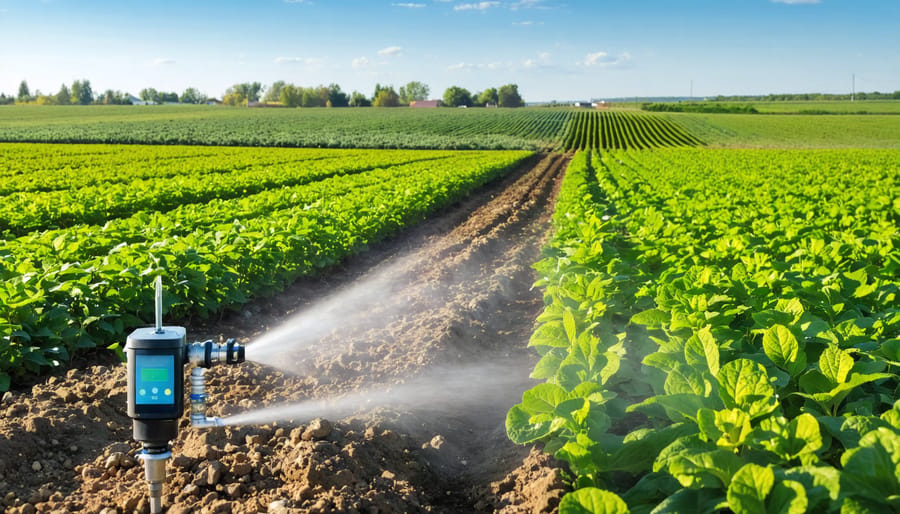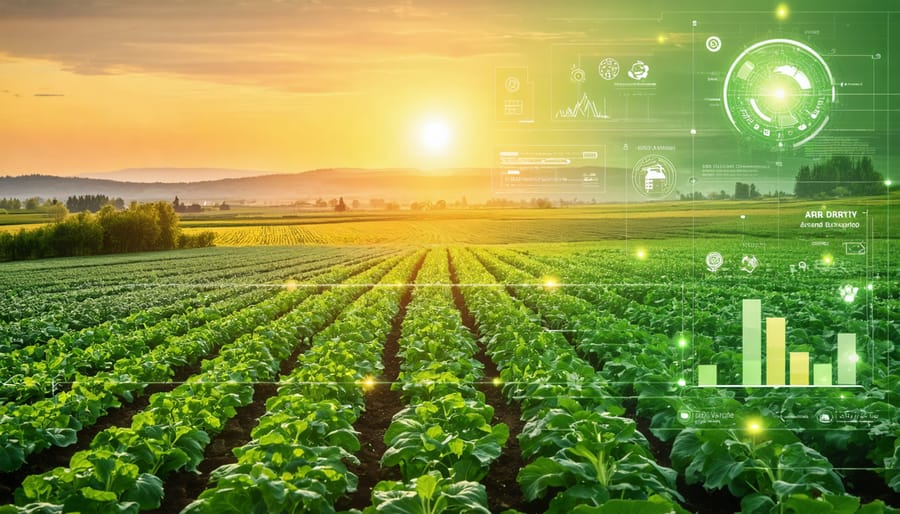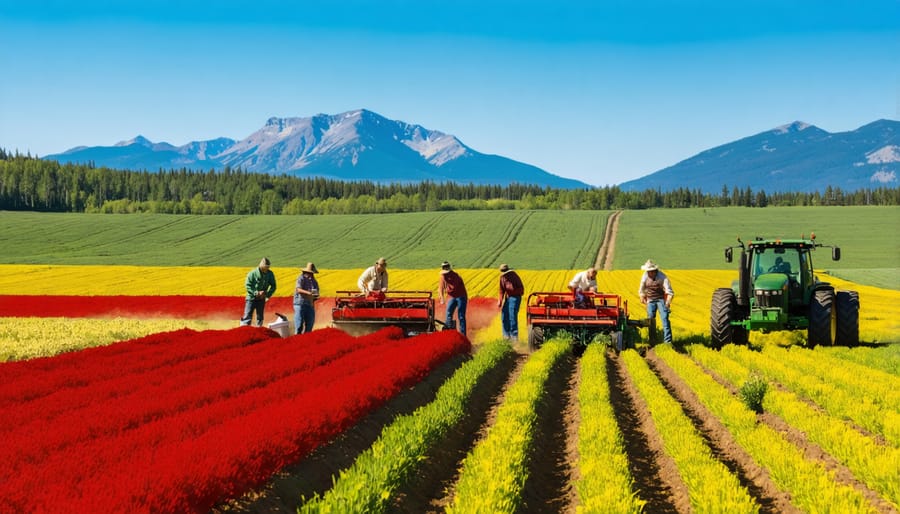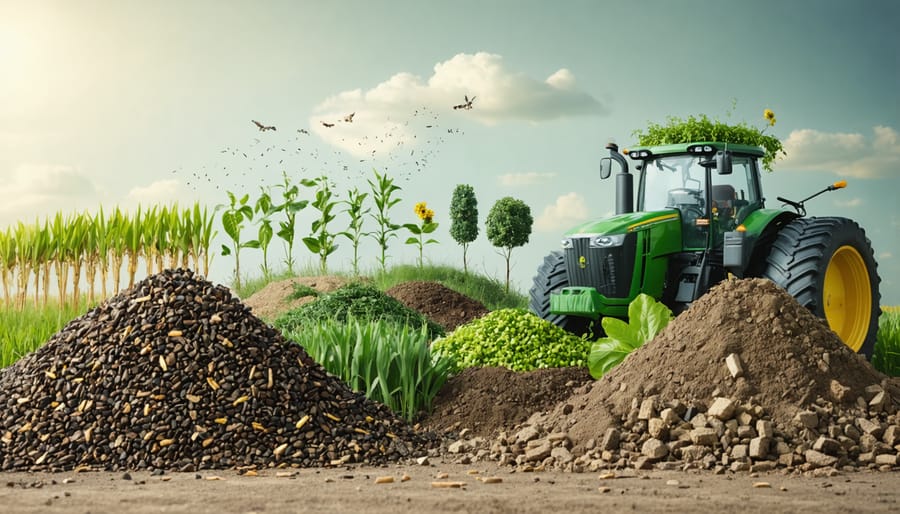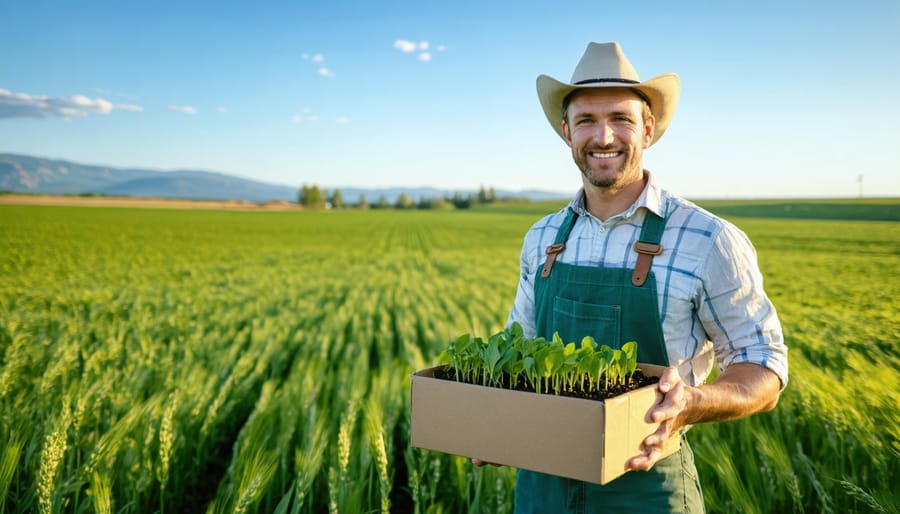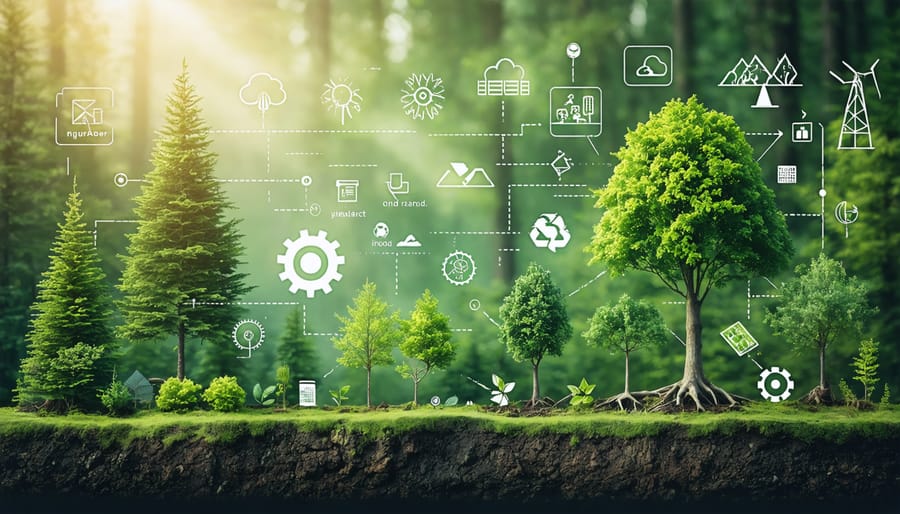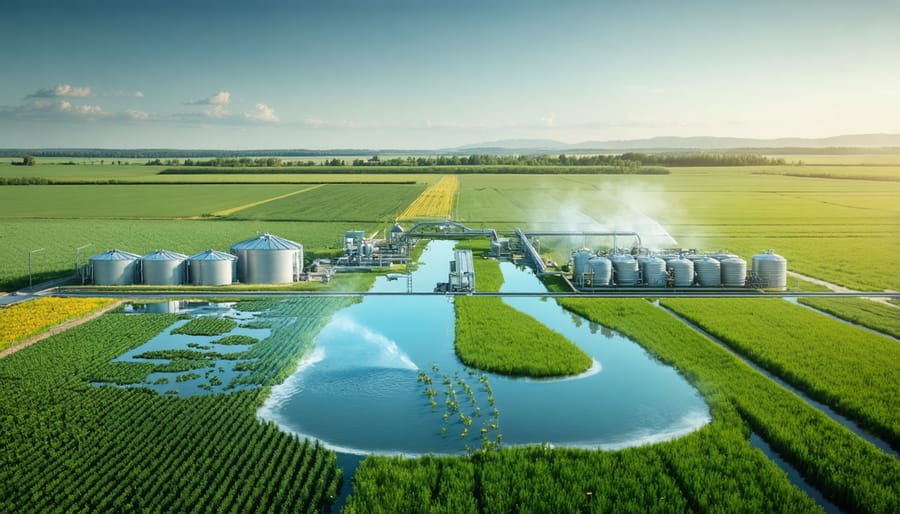Transform your landscape’s water efficiency by integrating smart irrigation controllers that automatically adjust watering schedules based on local weather data and soil moisture readings. Combat water waste in agricultural supply chains through precision drip systems that deliver moisture directly to plant roots, reducing evaporation by up to 70% compared to traditional sprinkler methods.
Design drought-resistant zones using native Alberta species like Blue Grama Grass and Prairie Coneflower, which thrive with minimal irrigation while supporting local biodiversity. Layer mulch 10-15 centimetres deep around plants to retain soil moisture, regulate temperature, and minimize water loss through evaporation.
Harvest rainwater from roof surfaces and implement grey water recycling systems to supplement irrigation needs during Alberta’s dry periods. Each millimetre of rain falling on a 100-square-metre roof surface yields 100 litres of usable water for landscape maintenance.
These proven conservation methods have helped Prairie region farmers reduce water consumption by 40% while maintaining productive, resilient landscapes that withstand our challenging climate conditions.
Water-Smart Design: The Foundation of Landscape Conservation
Strategic Plant Selection and Zoning
In Alberta’s diverse climate zones, strategic plant selection plays a crucial role in water conservation. By grouping plants with similar water needs together – a practice known as hydrozoning – farmers and landowners can significantly reduce water waste while maintaining healthy landscapes.
Start by assessing your property’s microclimates, considering factors like sun exposure, wind patterns, and soil conditions. Areas with high sun exposure and wind typically require more drought-resistant species, while sheltered spots can support plants with moderate water needs.
Native plants like Blue Grama Grass, Yarrow, and Prairie Coneflower have naturally adapted to our local conditions and typically require less supplemental watering. These species have developed deep root systems that help them survive our dry spells and harsh winters.
Consider creating moisture zones in your landscape: high-water zones near buildings or high-traffic areas, moderate-water zones in partially shaded areas, and low-water zones in outlying areas. This approach allows for efficient irrigation management and reduces overall water consumption.
For fruit and vegetable gardens, group crops based on their water requirements. For instance, place moisture-loving plants like lettuce and celery together, separate from drought-tolerant options like beans and squash. This arrangement helps prevent overwatering some plants while underwatering others.
Remember to factor in seasonal changes when planning your plant groupings. Spring moisture levels differ significantly from late summer conditions, so arrange plants to maximize natural rainfall patterns throughout the growing season.

Soil Management for Better Water Retention
Effective soil management is crucial for maximizing water retention in Alberta’s diverse agricultural landscape. By implementing advanced soil management technologies and time-tested practices, farmers can significantly improve their soil’s ability to hold moisture.
Adding organic matter through composting and cover cropping helps create a soil structure that acts like a sponge, holding water for longer periods. Many Alberta farmers have found success by incorporating locally sourced materials like straw and manure, which typically increase water retention by 20-30%.
Reduced tillage practices protect soil aggregates and maintain beneficial fungal networks that enhance water-holding capacity. Conservation tillage methods have shown particular success in our prairie regions, where moisture conservation is critical during dry periods.
Mulching with organic materials helps regulate soil temperature and reduce evaporation. A 10-centimetre layer of organic mulch can reduce water loss by up to 70% while improving soil structure over time.
Regular soil testing and pH management ensure optimal conditions for root development and water uptake. Consider incorporating calcium-rich amendments when needed, as they help improve soil structure and water retention properties.
Remember to adjust these practices based on your specific soil type and local conditions. Sandy soils may require more frequent organic matter additions, while clay soils benefit from techniques that improve drainage while maintaining moisture retention.
Advanced Irrigation Technologies for Canadian Farms
Smart Irrigation Controllers and Sensors
Modern smart irrigation controllers and sensors are revolutionizing how we approach water management in Canadian agriculture, forming a crucial component of sustainable farming practices. These innovative systems use real-time data and advanced algorithms to deliver precise amounts of water exactly when and where it’s needed.
For Alberta farmers, weather-based controllers have proven particularly valuable. These systems connect to local weather stations or use on-site sensors to monitor conditions like rainfall, temperature, and wind speed. When rain is forecast or soil moisture levels are adequate, the controllers automatically adjust or skip scheduled watering cycles, preventing unnecessary irrigation and conserving precious water resources.
Soil moisture sensors, installed at various depths throughout fields, provide continuous feedback about water availability in the root zone. This data helps farmers maintain optimal soil moisture levels without over-watering. Many Alberta producers report water savings of 30-50% after implementing these systems, while maintaining or even improving crop yields.
Flow sensors and smart meters add another layer of efficiency by detecting leaks and monitoring water usage patterns. These devices can immediately alert farmers to unusual flow rates, preventing water waste and potential crop damage from broken pipes or malfunctioning equipment.
The latest generation of smart controllers can be managed through smartphone apps, allowing farmers to monitor and adjust irrigation schedules remotely. This capability is especially valuable during extreme weather events or when managing multiple fields across different locations.
Integration with other farm management systems is becoming increasingly common. For example, many controllers can now coordinate with crop management software to adjust irrigation based on growth stages and specific crop water requirements. Some systems even incorporate evapotranspiration data to calculate precise water needs for different crops and soil types.
While the initial investment in smart irrigation technology may seem significant, many farmers report that the systems pay for themselves through water savings and improved crop quality within two to three growing seasons.
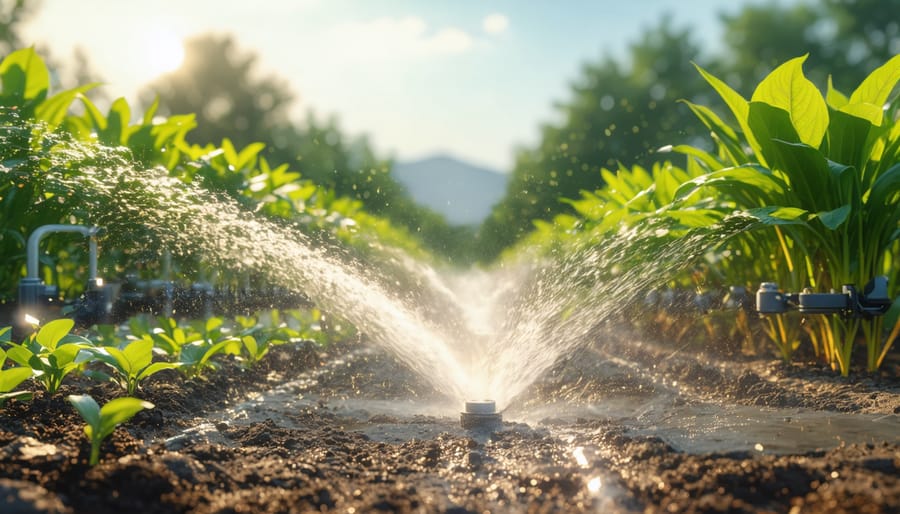
Drip Systems and Precision Application
Drip irrigation and precision application systems have revolutionized water conservation in Alberta’s agricultural landscape. These efficient delivery methods can reduce water usage by up to 60% compared to traditional irrigation methods while improving crop yields and quality.
Modern drip systems deliver water directly to plant root zones through a network of tubes with precisely placed emitters. This targeted approach minimizes evaporation and ensures crops receive exactly what they need, when they need it. For row crops like tomatoes and peppers, drip lines can be installed either above or below ground, while orchards and vineyards benefit from suspended drip lines that can be adjusted as trees mature.
“Since switching to drip irrigation, we’ve cut our water usage by half while increasing our berry yield by 30%,” shares Sarah Thompson, a strawberry farmer from Lethbridge. “The system practically pays for itself within two seasons.”
Precision application technologies have become increasingly sophisticated, incorporating soil moisture sensors, weather monitoring, and automated controls. These smart systems can adjust water delivery based on real-time conditions, preventing both under and over-watering. For Alberta farmers dealing with varying soil types and microclimates, this level of control is invaluable.
Different crops require different approaches:
– Root vegetables: Subsurface drip irrigation prevents surface crusting and reduces disease
– Leafy greens: Low-flow emitters provide consistent moisture without leaf wetness
– Field crops: Linear move systems with precision nozzles optimize coverage
– Tree fruits: Multiple emitters per tree ensure even root zone distribution
When combined with proper maintenance and regular system checks, these technologies can achieve water use efficiency rates of 95% or higher. This not only conserves water but also reduces energy costs associated with pumping and helps prevent nutrient leaching.
Regular maintenance is crucial – inspect filters monthly, flush lines seasonally, and check emitters for clogging to ensure optimal system performance. While initial installation costs may be higher than traditional irrigation methods, the long-term benefits to both farm operations and environmental sustainability make precision irrigation a worthwhile investment for Canadian farmers.
Water Recycling and Alternative Sources
Greywater Systems for Agricultural Use
Greywater systems offer Alberta farmers a practical approach to water conservation by recycling gently used water from sinks, showers, and laundry facilities for agricultural purposes. These circular water management systems can reduce freshwater consumption by up to 40% while providing reliable irrigation for crops.
Local farmer Sarah Thompson from Lethbridge implemented a greywater system that collects water from her farmhouse and worker accommodations, filtering it through a three-stage process before using it to irrigate her potato fields. “We’ve saved approximately 1.5 million litres of water annually since installation,” Thompson reports.
Key components of an agricultural greywater system include:
– Collection tanks (typically 5,000-10,000 litres)
– Filtration systems with organic matter removal
– UV sterilization units
– Distribution pumps and irrigation lines
– Soil moisture sensors for optimal application
When designing your system, consider seasonal variations in water availability and crop needs. Many Alberta farmers successfully use greywater for:
– Row crop irrigation
– Greenhouse operations
– Livestock facility cleaning
– Dust control in yards and roads
– Composting moisture management
Remember to check local regulations and obtain necessary permits before installation. The Alberta Agriculture and Forestry office provides free consultations to help farmers develop appropriate greywater systems for their specific operations.
Rainwater Harvesting Solutions
In Alberta’s variable climate, rainwater harvesting offers a sustainable solution for landscape irrigation while reducing dependence on municipal water supplies. A well-designed system can capture significant amounts of water during our spring and summer rainfall periods, providing a reliable water source for your agricultural needs.
Basic collection systems typically include roof catchment areas, gutters, downspouts, and storage tanks. For Alberta farms, we recommend installing storage tanks with a minimum capacity of 5,000 litres to ensure adequate supply during dry spells. Underground cisterns are particularly effective in our climate, as they protect water from freezing during winter months and maintain cooler temperatures during summer.
First-flush diverters are essential components that redirect the initial rainfall containing dust and debris away from your storage system, ensuring cleaner water for irrigation. Installing mesh screens over gutters and tank inlets prevents leaves and larger debris from entering the system, reducing maintenance requirements.
For optimal efficiency, consider implementing a dual-pipe system that allows you to switch between rainwater and municipal water when necessary. Many Alberta farmers have found success with automated systems that use soil moisture sensors to regulate irrigation timing and volume, maximizing the benefits of harvested rainwater.
When properly maintained, these systems can reduce your landscape water consumption by 30-50% annually, making them a worthwhile investment for sustainable farm management. Local agricultural extension services can provide detailed guidance on system design and installation specific to your property’s needs.
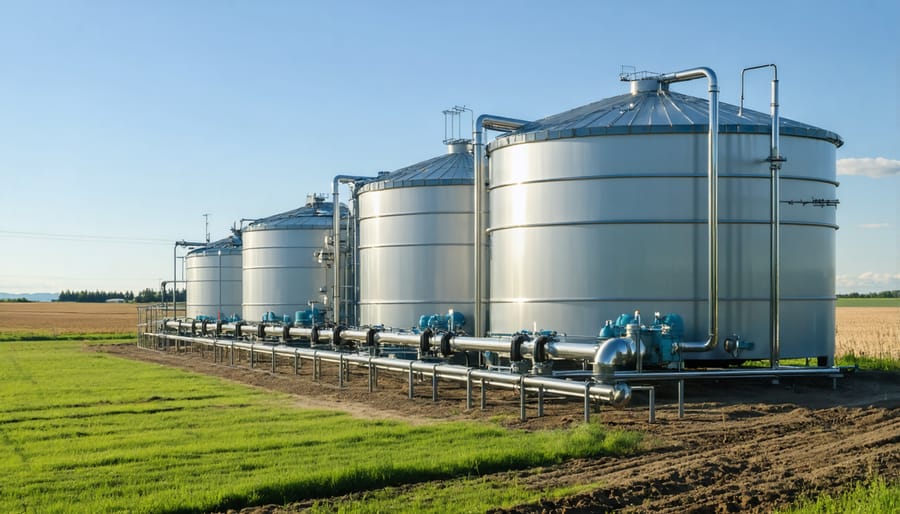
Alberta Success Stories: Real Farm Results
The Robertson family farm in Drumheller showcases how innovative Alberta farming practices can dramatically reduce water consumption while maintaining productivity. By implementing a combination of drip irrigation and soil moisture sensors, they’ve cut water usage by 40% over three years while increasing crop yields by 15%.
In Lethbridge County, the Martinez operation transformed their 800-hectare farm by adopting precision irrigation technology. Their system uses weather data and soil moisture mapping to deliver exactly what each section needs. The result? A 35% reduction in water use and a 20% decrease in energy costs for pumping.
The Coaldale Community Farm Collective demonstrates the power of collaborative water management. Five neighboring farms joined forces to create a shared water retention system, complete with constructed wetlands that naturally filter and store rainfall. This initiative has helped them reduce dependence on municipal water by 60% during peak growing seasons.
Near Red Deer, Sarah Thompson’s market garden operation proves that small-scale farms can achieve significant water savings. By implementing rainwater harvesting systems and drought-resistant landscaping, she’s created a nearly self-sufficient water system. Her methods have inspired local farmers to adopt similar practices, creating a ripple effect throughout the community.
The success of these Alberta farmers shows that water conservation isn’t just environmentally responsible – it’s economically smart. These case studies demonstrate how combining traditional knowledge with modern technology can create sustainable solutions that work for farms of all sizes. Their achievements have set new benchmarks for water efficiency in Canadian agriculture, proving that conservation and profitability can go hand in hand.
As we’ve explored throughout this guide, landscape water conservation is not just an environmental responsibility – it’s a smart business decision for Canadian farmers. By implementing the strategies we’ve discussed, from efficient irrigation systems to drought-resistant crop selection, you can significantly reduce water consumption while maintaining or even improving crop yields.
Remember that every farm is unique, and what works best for your operation may require some experimentation. Start with small changes, measure your results, and gradually expand successful practices across your land. The initial investment in water-efficient technologies and systems typically pays for itself through reduced water costs and improved crop resilience.
Our Alberta farming community has already shown remarkable innovation in water conservation. Many local farmers have reported water savings of 30-40% after implementing these practices, while maintaining profitable operations. These success stories demonstrate that sustainable water management is achievable and beneficial for Canadian agriculture.
Take advantage of available resources through local agricultural extension services and water conservation programs. Connect with fellow farmers who have successfully implemented these practices, and share your own experiences with the community. Together, we can build a more sustainable future for Canadian agriculture while preserving our precious water resources for generations to come.
The time to act is now. Start by assessing your current water usage and identifying areas for improvement. Every drop saved contributes to the long-term sustainability of our agricultural sector and the health of our environment.

